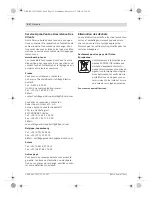
20
| English
2 609 004 767 | (17.11.10)
Bosch Power Tools
External Dust Extraction (see figure I)
Mount a vacuum hose
12
onto the extraction
outlet
10
. Connect the vacuum hose
12
with a
vacuum cleaner. An overview for the connection
of various vacuum cleaners can be found at the
end of these instructions.
The vacuum cleaner must be suitable for the ma-
terial being worked.
When vacuuming dry dust that is especially det-
rimental to health or carcinogenic, use a special
vacuum cleaner.
When working vertical surfaces, hold the power
tool in such a manner that the vacuum hose faces
downward.
Operation
Starting Operation
f
Observe correct mains voltage! The voltage
of the power source must agree with the
voltage specified on the nameplate of the
machine. Power tools marked with 230 V
can also be operated with 220 V.
Switching On and Off
To
start
the machine, push the On/Off switch
2
forward so that the
“1”
is indicated on the switch.
To
switch off
the machine, push the On/Off
switch
2
toward the rear so that the
“0”
is indi-
cated on the switch.
Preselecting the Orbital Stroke Rate
With the thumbwheel for preselection of the or-
bital stroke rate
1
, you can preselect the required
orbital stroke rate, even during operation.
The required stroke rate depends on the materi-
al and the working conditions and can be deter-
mined through practical testing.
After longer periods of working at low stroke
rate, allow the machine to cool down by running
it for approx. 3 minutes at maximum stroke rate
with no load.
Working Advice
f
Before any work on the machine itself, pull
the mains plug.
f
Wait until the machine has come to a stand-
still before placing it down.
Sanding Surfaces
Switch the machine on, place it with the com-
plete sanding surface on the surface to be
worked and move the machine with moderate
pressure over the workpiece.
The removal capacity and the sanding pattern
are mainly determined by the selection of the
sanding sheet, the preselected orbital stroke
rate and the applied pressure.
Only flawless sanding sheets achieve good
sanding capacity and extend the service life of
the machine.
Pay attention to apply uniform sanding pres-
sure; this increases the working life of the sand-
ing sheets.
Intensifiying the sanding pressure does not lead
to an increase of the sanding capacity, but to in-
creased wear of the machine and the sanding
sheet.
A sanding sheet that has been used for metal
should not be used for other materials.
Use only original Bosch sanding accessories.
Rough Sanding
Attach a sanding sheet with coarse grain.
Apply only light pressure to the machine so that
it runs at a higher stroke rate and high material
removal is achieved.
Fine Sanding
Attach a sanding sheet with fine grain.
By lightly varying the application pressure or
changing the orbital stroke rate, the sanding
plate stroke rate can be reduced whereby the
orbital action is maintained.
With moderate pressure, move the machine in a
circular pattern or alternately in lengthwise and
crosswise directions over the workpiece. Do not
tilt the machine to avoid sanding through the
workpiece (e.g. when sanding veneer).
After finishing the working procedure, switch
the power tool off.
1–2
Low stroke rate
3–4
Medium stroke rate
5–6
High stroke rate
OBJ_BUCH-1334-001.book Page 20 Wednesday, November 17, 2010 10:18 AM
















































